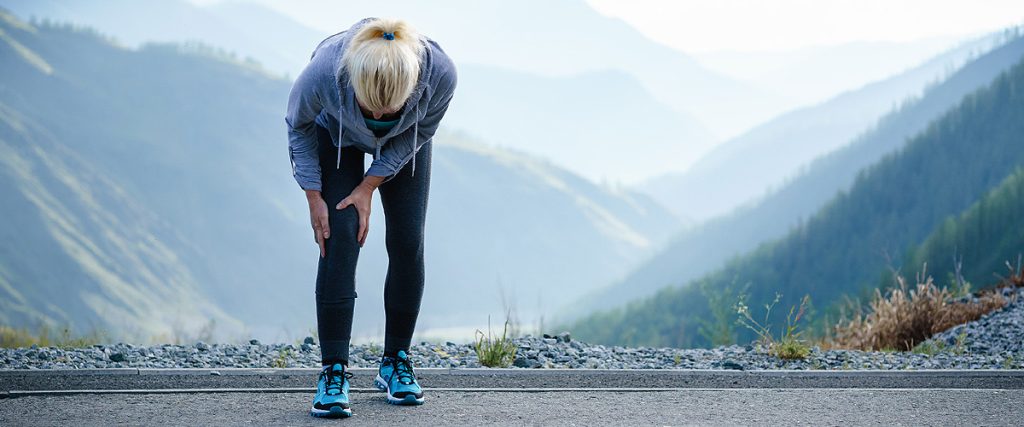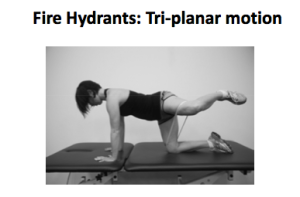The IT band is a long, fibrous band that is the extension of the tensor fascia lata muscle (and slips from the gluteus maximus) that originates at the outside of the pelvis, and the “band” portion attaches just below the outside of the knee.
The muscle moves the leg away from the body (abduction), bends the leg up (flexion), rotates the leg inward (internal rotation), and stabilizes the outside of the knee. Wow. It does so many things. BUT, its work is affected by the BUTT (let’s call it “the hip” which is the joint that the BUTT muscles (now to be called “the gluteal muscles”) surround and operate). Weak gluteal muscles / poor hip control can cause pain on the side of your knee called iliotibial band syndrome, or IT band syndrome.
How? And what can you do?
In running, when the hip / gluteal muscles are weak or poorly activated, it can’t manage the very high rates of loading and force that running demands of it, so other, often-times smaller muscles that can do (some) of the same functions as the weak gluteals (like the TFL that becomes the IT band) are left to carry that load. Then that muscle gets overused and often times, tight (because it’s being overused). Because, as mentioned above, the TFL turns the leg inward (internal rotation), and the weak gluteal muscles can’t well counteract that internal rotation torque, the (tight) TFL and its IT band get stretched / stressed, and can experience greater friction against the bony prominence or fat pad of the femoral lateral epicondyle that lies just beneath the IT band near the knee. This is (one) recipe for IT band pain at the outside of the knee.
What to do… you need to activate the gluteal muscles (especially the “work-horse” gluteus maximus) so they can do their critical job to control the hip to stop the hip from rotating inward and creating strain on the IT band. Also, stretch the TFL and foam roll or actively release the muscle and IT band with a tennis or lacrosse ball. This will decrease the tightness and, along with the ever-so-critical hip strengthening, will decrease the strain on the IT band. An additional, very critical element is learning how to activate your gluteal muscles when you run. It’s not enough to strengthen without learning how to use those (now stronger) muscles. This motor learning of a new, biomechanically optimal movement pattern is what research now plainly shows is critical for long-lasting rehabilitation results of orthopedic and musculoskeletal injuries.
Think about it… if you strengthen and stretch and get manual work on your tissues, etc., but you don’t know how to use the muscles differently (it’s difficult since you’ve been using the same motor pattern for a very long time, not knowing of its potential ill-effects until the body reaches a threshold and the pain starts), you will continue with the motor pattern that your brain / nervous system knows and that got you into this mess in the first place.
The IT band pain can unfortunately be a nagging, sometimes very long-lasting problem for runners and often-times sidelines them over and over again for months at a time. If you’re having knee pain, come in for a PT evaluation of the problem. We will move you through a customized program based on your particular knee issue.
There are numerous things to be done for IT band syndrome once the cause(s) of the pain are determined. The range of interventions includes: training adjustments (stop running through pain!), running analysis, modalities for pain, manual therapy, stretching, myofascial release, strengthening and movement re-training. Should weak hip muscles be a culprit, here is a great exercise:
FIRE HYDRANT: We love the fire hydrant! It does a beautiful job of activating the gluteus maximus (as seen on EMG in research and in the practice setting with surface EMG), the big boy in this scenario that MUST be working to abduct and externally rotate the hip during the landing / weight acceptance phase of running and support the TFL / IT band so it doesn’t get overloaded.
Note: the leg is lifting up and out at a 45 degree angle. Back is flat. You should feel this in the back of the hip / gluteus maximus. Try 15 second holds, alternating sides, for 3 – 4 minutes daily. Add a resistive band (of lowest resistance initially) to progress yourself. If the exercise is painful, stop and come in for PT!



